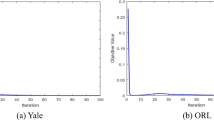Abstract
Great amount of data under varying intrinsic features are empirically thought of as high-dimensional nonlinear manifold in the observation space. With respect to different categories, we present two recognition approaches, i.e. the combination of manifold learning algorithm and linear discriminant analysis (MLA+LDA), and nonlinear auto-associative modeling (NAM). For similar object recognition, e.g. face recognition, MLA + LDA is used. Otherwise, NAM is employed for objects from largely different categories. Experimental results on different benchmark databases show the advantages of the proposed approaches.
Access this chapter
Tax calculation will be finalised at checkout
Purchases are for personal use only
Preview
Unable to display preview. Download preview PDF.
Similar content being viewed by others
References
T. Hastie, and W. Stuetzle (1988) Principla Curves. Journal of the American Statistical Association, 84(406), pp. 502–516
B. Kégl, A. Krzyzak, T. Linder, and K. Zeger (2000) Learning and design of principal curves. IEEE Transactions on Pattern Analysis and Machine Intelligence, vol. 22, no. 3, pp. 281–297.
C.M. Bishop, M. Sevensen, and C.K.I. Williams (1998) GTM: The generative topographic mapping. Neural Computation, 10, pp. 215–234
K. Chang and J. Ghosh (2001) A unified model for probabilistic principal surfaces. IEEE transactions on Pattern Analysis and Machine Intelligence, 23(1), pp. 22–41
A.J. Smola, S. Mika, et al (1999) Regularized Principal Manifolds. In Computational Learning Theory: 4th European Conference, Vol 1572 of Lecture Notes in Artificial Intelligence, New York: Springer, pp. 251–256
J. B. Tenenbaum, de Silva, V. & Langford, J.C (2000) A global geometric framework for nonlinear dimensionality reduction. Science, 290, pp. 2319–2323
V. S. Silva, J. B. Tenenbaum (2002) Unsupervised learning of curved manifolds. Nonlinear Estimation and Classification, Springer-Verlag, New York
S. T. Roweis, and K. S. Lawrance (2000) Nonlinear Dimensionality reduction by locally linear embedding. Science, 290, pp. 2323–2326
Mikhail Belkin, and Partha Niyogi (2003) Laplacian Eigenmaps for Dimensionality Reduction and Data Representation Neural Computation, 15(6), 1373–1396.
G. Hinton and S. Roweis (2002) Stochastic Neighbor Embedding. Neural Information Proceeding Systems: Natural and Synthetic, Vancouver, Canada, December 9–14
M. Brand, MERL (2002) Charting a manifold. Neural Information Proceeding Systems: Natural and Synthetic, Vancouver, Canada, December 9–14
Dick de Ridder, Robert P.W. Duin (2002) Locally Linear Embedding for Classification. Technical Reports, Delft University of Technology, The Netherlands
Daniel L. Swets and John (Juyang) Weng (1996) Using Discriminant Eigenfea-tures for Image Retrieval. IEEE Transactions on Pattern Analysis and Machine Intelligences, Vol. 18, No. 8, pp.831–836
F. S. Samaria (1994) Face Recognition Using Hidden Markov Models. PhD thesis, University of Cambridge
H. Wechsler, P. J. Phillips, V. Bruce, F. Fogelman-Soulie and T. S. Huang (1998) Characterizing virtual Eigensignatures for General Purpose Face Recognition. Daniel B Graham and Nigel M Allinson. In Face Recognition: From Theory to Applications; NATO ASI Series F, Computer and Systems Sciences, Vol. 163, pp. 446–456
Michael J. Lyons, Julien Budynek, and Shigeru Akamatsu (1999) Automatic classification of Single Facial Images. IEEE Transactions on Pattern Analysis and Machine Intelligence, vol.21, no. 12, pp. 1357–1362
Prey, P. W., Slate, D. J. (1991). Letter recognition using holland-style adaptive classifiers. Machine Learning, 6, 161–182
Kumar, S., Ghosh, J., Crawford, M. (2000) A Bayesian Pairwise Classifier for Character Recognition. Cognitive and Neural Models for Word Recognition and Document Processing. Nabeel Mursheed (Ed), World Scientific Press
Steve Lawrence, C. Lee Giles, A. C. Tsoi, and A. D. Back (1997) Face recognition: A convolutional neural network approach. IEEE Transactions on Neural Networks, vol. 8, no. 1, pp. 98–113
Y. Moses, Y. Adini, and S. Ullman (1994) Face Recognition: The Problem of compensating for changes in illumination direction, in Proceedings of the European Conference on Computer Vision, vol. A, pp: 286–296
M. Turk, and A. Pentland (1991) Eigenfaces for Recognition. Journal of Cognitive Neuroscience, vol 3, no.1, pp.71–86
Junping Zhang, Stan Z. Li, Jue Wang (2004) Nearest Manifold Approach for Face Recognition. The 6th IEEE International Conference on Automatic Face and Gesture Recognition, May 17–19, Seoul, Korea, 2004.
Junping Zhang (2003) Manifold Learning and Applications. PhD Thesis, Institute of Automation, Chinese Academy of Sciences, Beijing, China.
Author information
Authors and Affiliations
Editor information
Editors and Affiliations
Rights and permissions
Copyright information
© 2005 Springer-Verlag Berlin Heidelberg
About this chapter
Cite this chapter
Zhang, J., Li, S.Z., Wang, J. (2005). Manifold Learning and Applications in Recognition. In: Tan, YP., Yap, K.H., Wang, L. (eds) Intelligent Multimedia Processing with Soft Computing. Studies in Fuzziness and Soft Computing, vol 168. Springer, Berlin, Heidelberg . https://doi.org/10.1007/3-540-32367-8_13
Download citation
DOI: https://doi.org/10.1007/3-540-32367-8_13
Publisher Name: Springer, Berlin, Heidelberg
Print ISBN: 978-3-540-23053-3
Online ISBN: 978-3-540-32367-9
eBook Packages: EngineeringEngineering (R0)




